How to Chop Cilantro
Updated Jun 07, 2021
Follow my step-by-step method to chop cilantro quickly for salsas & many recipes. Learn the best knife skills for cutting safely & efficiently
This post may contain affiliate links. Please read our disclosure policy.
Knowing how to chop cilantro will help you add the perfect flavor to all sorts of salsas, as well as Lebanese and Asian dishes. Important to know: fresh cilantro is superior to dried, and cilantro is used to finish dishes. It loses oomph when simmered.
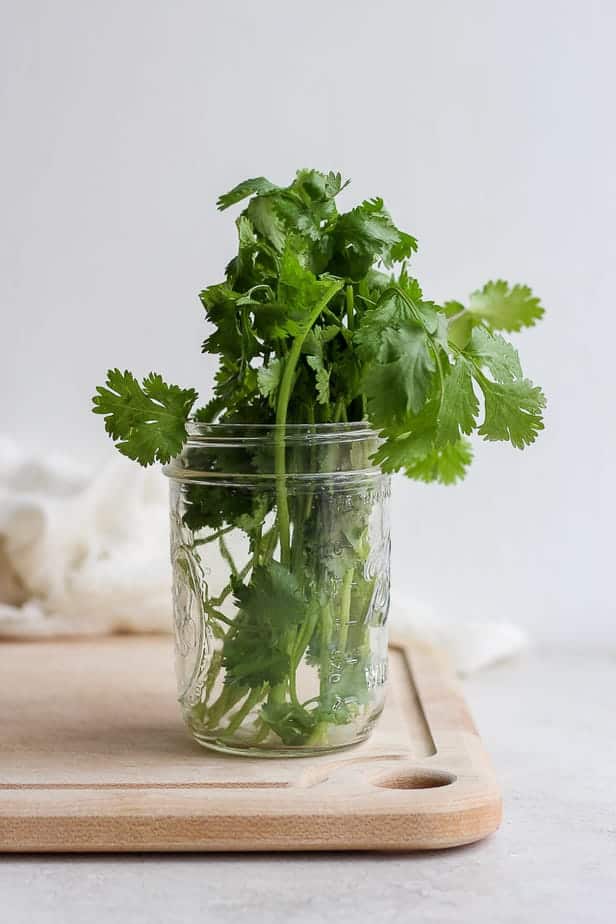
How do you clean cilantro?
Those plastic clamshells or bunches of herbs might look clean but unless specifically labeled as prewashed, you need to rinse away any bacteria, dirt, or chemical residual. Here are my tips:
- Rinse under cold running water, shaking to make sure all leaves get washed.
- Or soak in a bowl of cold water and swish gently to remove dirt.
- If you are worried about bacteria, you can add white vinegar (two tablespoons vinegar for every one cup water) to the soak. Rinse afterward and be forewarned this can affect the taste.
- Remember, using bleach or other strong solutions to rinse produce can make you sick.
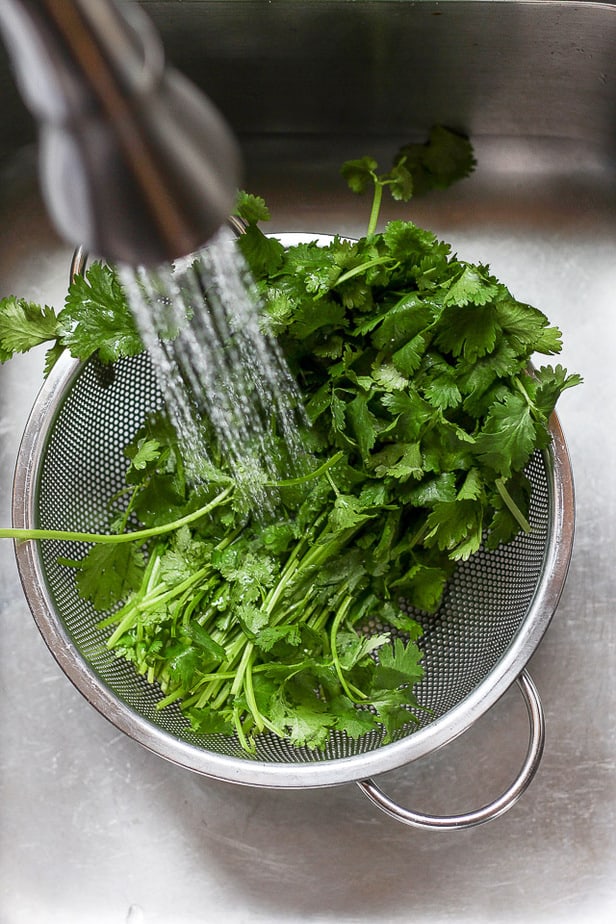
Next, dry by laying on paper towels and blotting. Or spin in a salad spinner if you have one.

How do you cut cilantro?
Start by lining up the cilantro bunch and use a sharp knife to cut off the larger, bottom stems especially if they are thick and woody. For a fine mince? Keep a longer length of the more tender stems but know they have a stronger flavor than the leaves. If you are chopping into large pieces or using whole leaves, toss the stems.
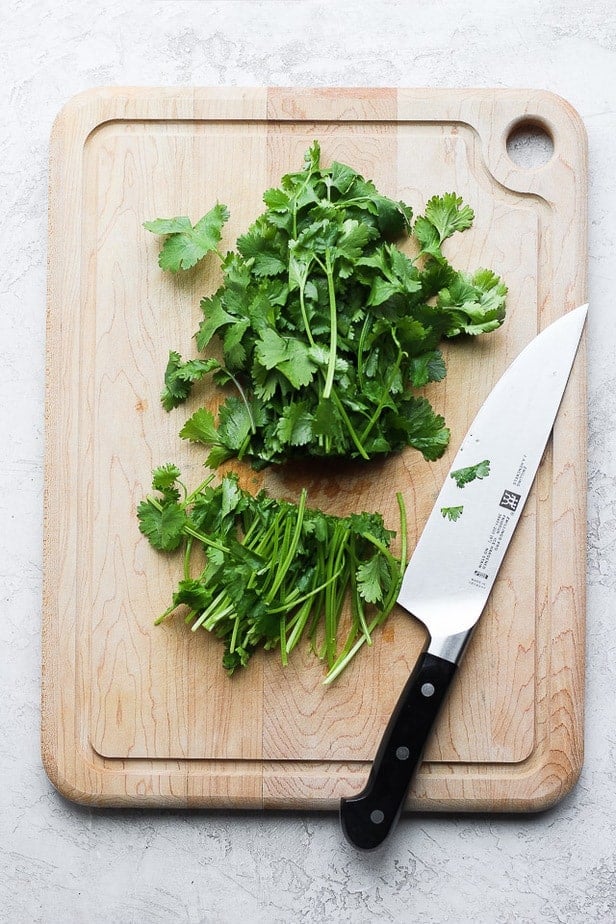
Fold the cilantro bunch in half the long way and use a rocking motion with the knife to chop horizontally as finely as needed.
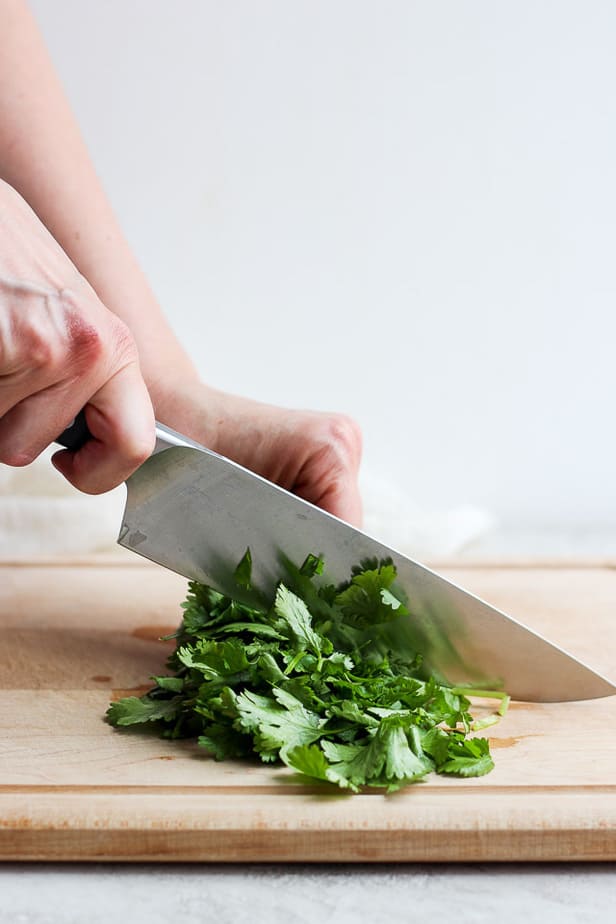
How do you store cilantro?
For chopped cilantro
Chopped cilantro needs to be frozen to last more than a day. Pack into ice cube trays and fill out with some water or olive oil. Once frozen the cubes can be transferred to a baggie or silicon bag. You can also pack them flat in a freezer-safe bag without any water or oil.
For whole cilantro
I’ve had good luck with two different storage methods. I prefer to wash the cilantro so that it’s ready to use, especially if I know I’m using it within a week. However, washing it can create excess moisture on the leaves which may make the cilantro decay faster. Both methods work for washed or unwashed cilantro.
- Storage Method 1: Place like a bunch of flowers in a glass jar covered by a plastic or silicon bag. You can trim the bottom of the sticks and be sure to change out the water every 3-5 days.
- Storage Method 2: Roll the cilantro in a clean, damp (not wet!) paper towel, then roll the whole bundle into a plastic or silicon bag.
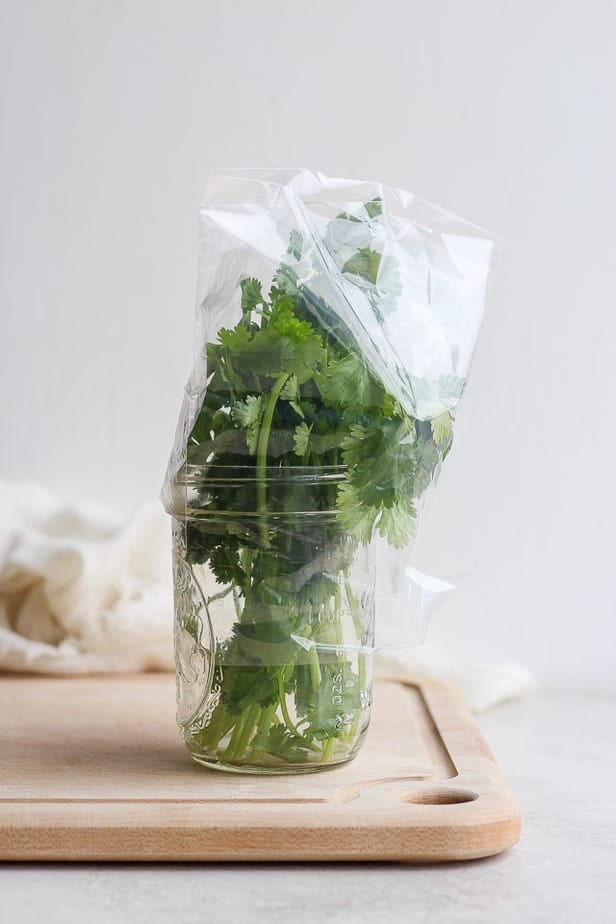
Recipes with cilantro
- Cilantro Chicken and Veggie Skewers
- Cilantro Lime Cauliflower Rice
- Garlic Cilantro Oven Baked Salmon
- Grain Bowls – 3 Ways
- Lebanese Spinach Stew
- Lebanese Spicy Potatoes (Batata Harra)
- Okra Stew
- Simple Guacamole
- Green Shakshuka
- Chicken Burrito Bowl
- Avocado Hummus Dip
- Lebanese Bean Stew
- Cauliflower Curry
- Peas and Carrots Stew
- White Bean Salad
- Cilantro Yogurt Sauce
Frequently asked questions
Once chopped, you should use the cilantro within a couple days for best flavor. However, storing it with its stems in either method shared above can actually make the cilantro last for up to 2 weeks, especially if unwashed.
In the U.S., cilantro refers to the leafy herb and coriander refers to whole or ground seeds from the same plant. The seeds have a warmer flavor profile. Outside the U.S. coriander means both the leaf and the seed.
It is not the same. Essential oils are lost in the drying process and and dehydration concentrates the flavors in a way that makes them different.
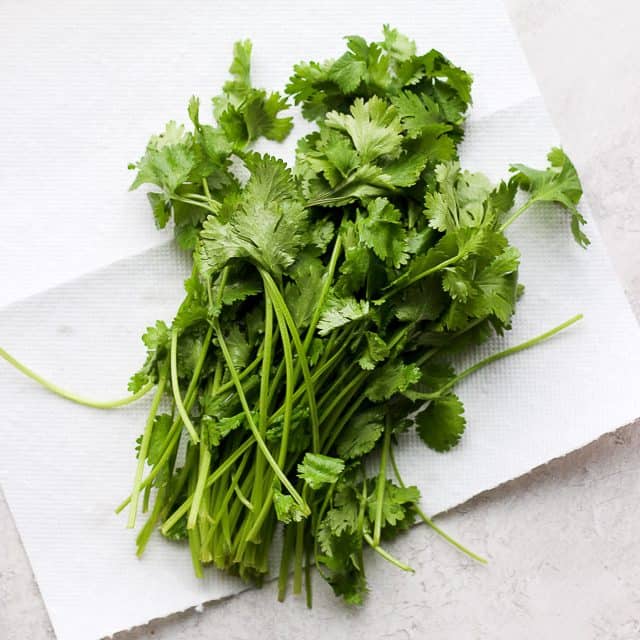
Cilantro, an assertive herb, pops out in cuisines all over the world from the Middle East and Africa to Asia and Latin America. Plus, it also boasts vitamins A and C and tiny amounts of calcium and iron. Chop some up today!
For more cooking resources, check out:
- How to Cut a Tomato
- How to Freeze Garlic
- How to Properly Cut an Onion
- How to Cut an Avocado
- How to Cook Dry Chickpeas
- How to Cut a Head of Lettuce
- How to Cut Cauliflower into Florets
- How to Make Oatmeal
- How to cut a melon
- How to Cut a Kiwi
If you’ve found this cooking resource for How to Cut Cilantro helpful or if you’ve tried any recipe on Feel Good Foodie, then don’t forget to rate the recipe and leave me a comment below! I would love to hear about your experience with this technique. And if you snapped some shots of it, share it with me on Instagram so I can repost on my stories!

How to Cut Cilantro
Ingredients
- 1 bunch cilantro
Instructions
- Place the cilantro in a colander and wash with cold water for a few minutes to loosen and remove any dirt. Dry on paper towels or in a salad spinner.
- Decide how much cilantro you want to use and store the remainder in a mason jar filled with water. You want to place the cilantro stems down into the water and cover with a clear plastic bag. You can place a rubber band around the bag to keep the bag in place. Store in the refrigerator for up to 2 weeks.
- For the remaining cilantro you’ll use in your recipe, transfer the washed cilantro to a salad spinner or paper towel to dry as much as possible.
- Line up the cilantro bunch together and use a sharp knife to cut off where the stems start to look larger. The stems have a more concentrated flavor, so you can decide how much or little you want to keep for the recipe.
- Fold the remaining cilantro bunch in half the long way and use a rocking motion with the knife to chop as finely as needed.
- Use in your recipe as needed.
Notes
- Storage Method 1: Place like a bunch of flowers in a glass jar covered by a plastic or silicon bag. You can trim the bottom of the sticks and be sure to change out the water every 3-5 days.
- Storage Method 2: Roll the cilantro in a clean, damp (not wet!) paper towel, then roll the whole bundle into a plastic or silicon bag.
Nutrition
Nutrition information provided is an estimate. It will vary based on cooking method and specific ingredients used.






Comments
White vinegar has no effect on killing bacteria. One tablespoon of bleach should be used for every liter of water, leave the leaves to soak in that solution for ten minutes, and then RINSE the leaves to remove bleach residue. This is the only way to fight bacteria on vegetables.
Hi Sandra, thanks for the suggestion. I have to respectfully disagree here. While vinegar is not ideal for use as a general disinfectant or on viruses, studies have shown that vinegar does inhibit food-borne bacteria. I would not feel comfortable using bleach on produce myself, so for those of us who feel wary, vinegar is a great option.